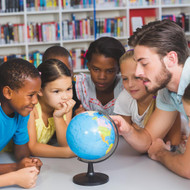7 Ways to Create Cultural Awareness in the Classroom
Posted by Jenna Cicero on Jan 17th 2023

When teaching a foreign language, it’s natural to introduce your students to the rich culture that accompanies that language. But how natural is it for you to introduce other cultures when teaching subjects such as social studies, science, language arts, or art?
Teaching diversity in the classroom is a huge benefit for students because it promotes critical thinking, helps to prevent prejudice and more. Unfortunately, not all students get that kind of exposure, and that begs the question: How can teachers better create cultural awareness in the classroom?
This article looks at inclusion classroom strategies and fun practical ways in which you can expose your students to a host of different cultures and inclusion in the classroom.
Items you will need from various cultures:
- Books
- Movies with subtitles
- Artwork, flags, and other representative items
- Music
- Recipes
Step 1: Research Different Cultures
At the beginning of the school year or whenever you have time, send a survey home with students to fill out with their families to get to know their cultural background better. This is also a great way for parents to interact with their children while they learn more about their family’s history and culture! You can even create a display in the classroom that shows all the diverse ethnicities that are amongst your students, so they can get to know more about each other, too!
Research the cultures of your students as well as cultures they won’t have direct exposure to. This will help you find balance when planning your lessons and activities. The most important part of introducing another culture is having the facts. As a teacher, you should be able to engage with your students and answer questions they may have about the cultures being taught in the classroom. A great place to start is history.com .
Step 2: Hands-On Activities
Kindness is key for creating a welcoming space for all students, and a great way to showcase kindness in the classroom is with free kindness worksheets for kids, these worksheets are a great way for children to practice being a good friend, welcoming different cultures and backgrounds, and spreading words of kindness to each other. Activities like STEM Challenges are also a great way to have students practice kindness while building their STEM learning and social-emotional learning skills.
Step 3: Music Hour
Choose an hour during the day when students are performing basic tasks and play music from a specific culture. Engage with students by asking them how the music sounds to them, what it reminds them of, and what they think the lyrics mean within the context of when and where it was created. Be sure to choose songs that have age-appropriate content.
Step 4: Cultural Corner
Create a cultural corner in the classroom with diversity and inclusion classroom décor! Decorate your corner with All Are Welcome multicultural classroom decorations, or inclusive classroom décor like the Open hearts, Open Minds Bulletin Board Set. Each month, you can re-decorate this section based on a different cultural group. You can ask your students to bring items in that represent that culture and showcase them in the display. These items could include flags, books, magazines, artwork, toys, instruments, dictionaries, and more. You can pick and choose posters from the Be an Ally Like Me Poster Set that feature inspirational leaders from the culture you are highlighting that month, or create one large display that celebrates diversity and inclusion in the classroom all year long!
Step 5: Flavorful Cook-Off
Another great activity to help strengthen cultural awareness in the classroom is a cook-off. At the end of the year, you could ask students to prepare a dish at home from one of the cultures you studied. Let them know that they’ll share the food with the rest of the class.
To keep it simple, choose basic dishes from each culture and provide students with recipes to follow. Ask the students to present some facts about the culture when they bring in their dishes, then have the rest of the class ask questions and talk about the flavors they taste in the food.
Before beginning any food activity, ask families’ permission and inquire about students’ food allergies and religious or other food restrictions.
Step 6: Real-Life Story Time
Take your cultural history lesson to the next level by sharing a real-life story of an individual from the time period you wish to highlight. You can do this in two ways:
- Read a story from a biography or an online publication. The story should be interesting and include many references to the person’s specific culture and customs.
- Give your students the chance to tell stories about people from different cultures or backgrounds. Students can choose someone from their families or someone they’ve studied for homework.
Children’s books like the Katie Can and Carl Can series are a great way to highlight diversity through engaging stories and vivid illustrations that teach kids about other children just like them with special abilities.
Step 7: Who Am I? Poems
If you teach middle-school students who are a bit older, you can instruct them to write a poem that explains how they identify with being from a certain culture. Even if you don’t have a diverse class it will be educational and interesting to see how your students perceive their own cultural ideals, standards, and customs.
Creating cultural awareness is of the utmost importance in our increasingly diverse world. It’s important to teach our youth how to not only live in but also support a society that welcomes the rich knowledge and perspective that comes with learning about different cultures.

